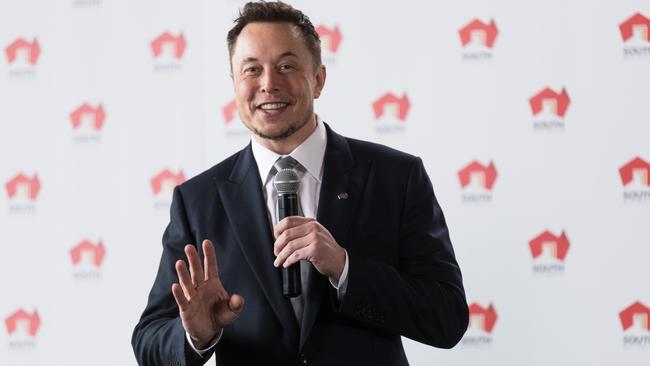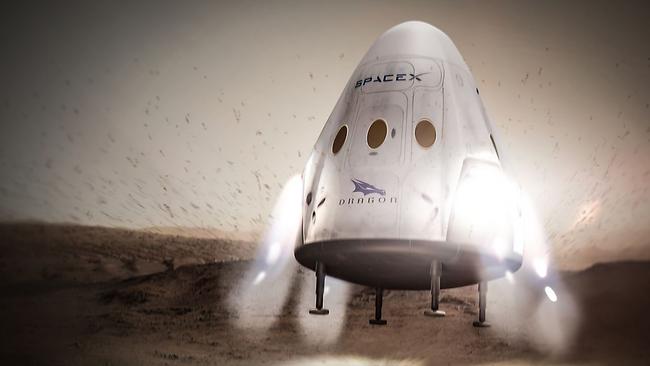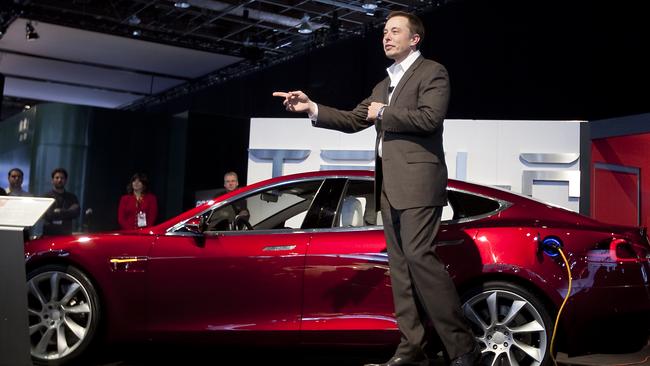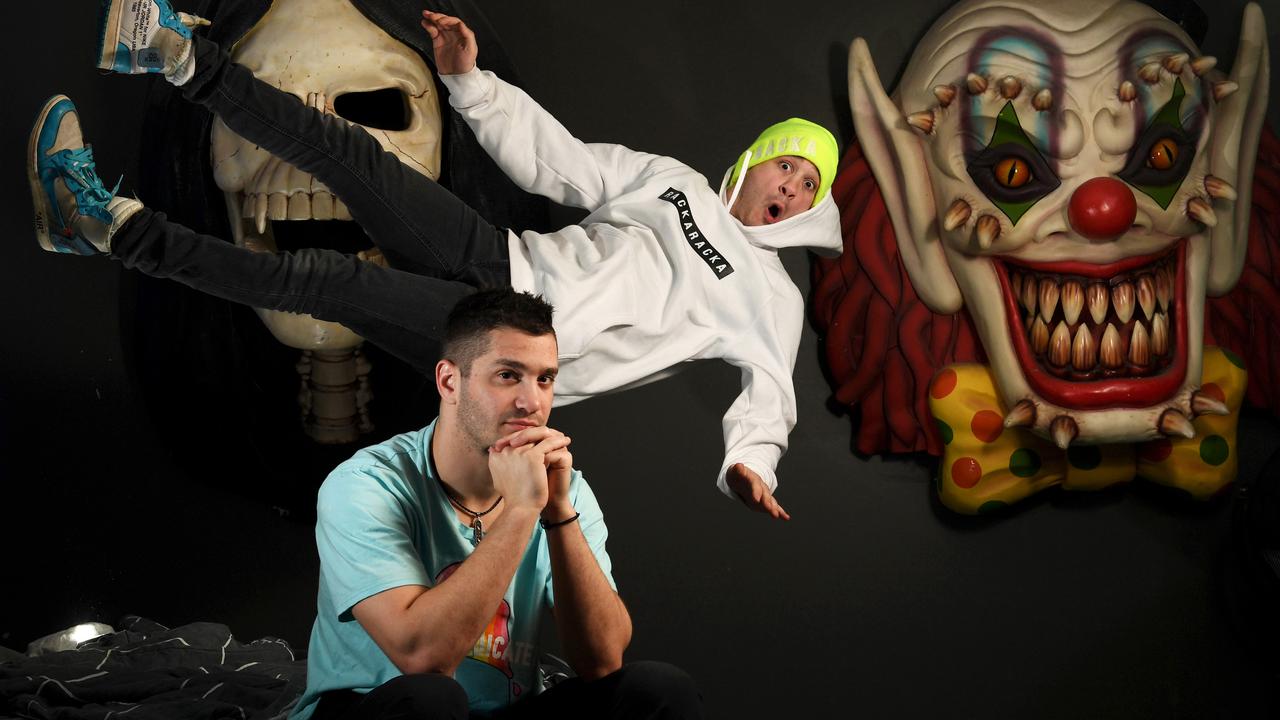With his electric cars, space ships and huge batteries, is Elon Musk the man to save South Australia?
WITH his Tesla electric cars and Space X rockets, Elon Musk has become one of the world’s most fascinating characters. But how realistic are his dreams of colonising Mars and powering the world?

SA Weekend
Don't miss out on the headlines from SA Weekend. Followed categories will be added to My News.
ELON Musk wants to die on Mars. Not in a bad way or anything. Not in a fireball as his spaceship crashes into the red planet.
No, he sees it more as the place to spend his retirement years before he shuffles off this, or is it that, mortal coil.
“Ideally I’d like to go for a visit, come back for a while, and then go there when I’m like 70 or something and then just stay there,” says the billionaire driving force behind electric car company Tesla, and spaceship manufacturer SpaceX.
If a Mars death wish suggests something about Musk’s odd, and somewhat eccentric personality, then so does his vision of where he sees his family fitting into this equation.
“If my wife and I have a bunch of kids, she would probably stay with them on Earth.”
OK. See you dear. See you dad. Have a nice life. Give my regards to Mars.
The 46-year-old Musk has long been an advocate of colonising Mars. It’s one of the reasons he started SpaceX.
He believes humanity is going to have to set up shop on the Red Planet as we will eventually destroy this one. But, as he also believes humanity is a computer simulation being run by a super-intelligent, post-human civilisation, a bit like in The Matrix, it’s difficult to see why he bothers.
Musk outlined his wish to die on Mars to Ashlee Vance, a reporter who detailed the billionaire’s somewhat bizarre life in a biography called Elon Musk: How the Billionaire CEO of SpaceX and Tesla is Shaping Our Future.
While Vance is mostly on the side of Musk, he also doesn’t shy away from some of the more unsettling character traits of a man many consider a genius. The poor treatment of employees and friends. The unrelenting pursuit of perfection and his intolerance for anyone not as committed as he is. His mountainous ego.

There is no doubt Musk is a fascinating personality. Actor Robert Downey Jr used him as a base for his Iron Man character Tony Stark. He has a fondness for expensive cars and private jets. He has just split up with Hollywood actor Amber Heard, the ex-wife of Johnny Depp. He argues with Facebook founder Mark Zuckerberg about whether artificial intelligence will wipe out humanity. He also believes artificial intelligence will cause World War III.
Musk made a surprise visit to Adelaide in July to launch what he and premier Jay Weatherill called the “world’s biggest lithium ion battery”, which will be built near Jamestown in the state’s Mid North.
Amid all the hoopla and the backslapping, what was left unacknowledged was that what brought Musk to town was the SA Government’s desperation to find a fix to an electricity crisis that had seemingly spiralled out of control.
Now Musk is returning to Adelaide for the International Astronautical Conference being held at the Convention Centre from September 25. Musk will address the conference on the Friday afternoon “with an update on his plans for settling Mars”, according to the official conference website. Musk’s address will also be streamed live globally.
If Musk’s ambitions seem fantastical, it’s because they are. But it doesn’t mean they are unachievable. Plenty wrote off his plans for SpaceX and Tesla. And there were many setbacks along the way, and there could easily be more in future, yet both companies have pushed the cause of privately funded space travel and electric cars forward.
The ultimate success of both companies is still far from certain but the scale of Musk’s ambition and his unrelenting pursuit of advancing technology means he has taken over the “king of the geeks” mantle vacated when Apple’s Steve Jobs died in 2011.

There is certainly a quality of the cult leader about Musk. It was evident at his press conference in Adelaide when the State Government brought in a bundle of public servants to ooh and aah in all the right places. It was evident on the face of Premier Jay Weatherill, who looked like he was having the time of his life up on a stage at the Adelaide Oval, with Musk, simultaneously starstruck, awe-struck and a little in love.
But it was a strange press conference. The Government wouldn’t even confirm Musk was showing up until the last minute. Then, when his private jet was safely on the ground, more instructions were issued.
There was to be no flash photography, which meant the room at the Adelaide Oval was filled with half a dozen huge lights and enormous light diffusers and reflectors to ensure light was reflected evenly across the stage. There were to be no questions that didn’t relate to the big battery. If there were, there was a chance Musk would leave the room. Oh, and Musk wouldn’t pose for any photos. Quite the drama queen.
In some ways, Musk’s attraction to South Australia is not a surprise. Another of his ambitions is to end the world’s reliance on fossil fuels. He has a company that makes batteries, another which makes solar panels. Then there are his Tesla cars, the latest being the much-hyped Model 3.
Much of his fortune has been built with government money. Those cars attract heavy US government backing. His spaceships rely on decades of publicly funded research, and NASA has signed up SpaceX to billions of dollars worth of contracts to ferry cargo to the International Space Station.
Precise figures for how much South Australia is paying Musk for his battery are still unclear but it’s thought to be about $50 million. Musk did insert a caveat that if he can’t build it in within 100 days of contracts being signed then it would be free, but although that agreement still hasn’t been signed, construction has started at Jamestown and the site is expected to be operational by December 1 — in 76 days time.
It was an unusual set of circumstances that brought Musk to South Australia. What started as a Twitter dare to solve SA’s power crisis from Australian software billionaire Mike Cannon-Brookes to Musk escalated quickly. Weatherill joined in, even though within a couple of days he was to announce a $550 million plan, which included a tender for a big battery, that he hoped would dig him out of the energy hole that was threatening his chances of re-election.
It was on Twitter on March 10 that Musk first made his “100 days or it’s free” pledge. The next day he was on the phone to Weatherill.
“I painted him a picture of South Australia, of the fact that we have an extraordinary amount of renewable energy resources but we didn’t have any storage capacity,” Weatherill says. During the conversation, Weatherill invited Musk to South Australia if it ever reached the stage of an announcement being made. Weatherill says he wasn’t sure until the last minute that Musk was coming. The billionaire was held up by a delay in the launch of a SpaceX rocket in California. But once that was sorted out he hopped onto his Gulfstream G650 private jet and made his way to Adelaide.
Weatherill says he had a good chat with Musk both before and after the now famous press conference at the Adelaide Oval.
“Like a lot of highly intelligent people, the impression you get is he lives a lot of his life in his head,” he says. “He has that reserve that you see in highly intelligent people.
“After a while when we began chatting he warmed up and was very friendly and very engaging. He just was genuinely excited about the idea of taking on these big questions and providing leadership. The longer we chatted, the more excited and enthusiastic he was about this opportunity.”
Weatherill says Musk will talk more about the battery when he returns this month. There is a lot riding on it for Musk as well. South Australia is something of a test case for his battery technology, which some believe is what he is most interested in selling, more than even his electric cars and spaceships.
Musk has built a giant battery factory in Sparks, Nevada, which produces not only the power plants for his cars but also the Powerpack batteries which will be used in the Jamestown project.
The Musk story starts in South Africa. It was, according to the Vance biography, a tough upbringing. Speaking of his father Errol, Musk told the reporter he “did not have a good childhood”.
“It was like misery. He’s (his father) good at making life miserable — that’s for sure. He can take any situation, no matter how good it is, and make it bad. He’s not a happy man.”
Aged 17, Musk fled South Africa and moved to Canada where he was eligible for citizenship through his mother, Maye. He spent a year moving from job to job, the nadir of which was cleaning the leftover crap out of a boiler in a lumber mill.
But then there was an internship at a bank and he started studying at Ontario’s Queen’s University before transferring two years later to the University of Pennsylvania to study economics and physics.
By 1995 he was making his first move into the world of business alongside his brother Kimbal. As well as physics and economics, Musk was fascinated by computers and had spent a lot of time pulling them apart, customising them and putting them back together. He had also become very good at writing computer code, a talent he had developed since his early boyhood days in South Africa.
It was natural then that by 1995, Musk would be increasingly interested in the nascent internet world. He developed an idea to compile a searchable list of businesses online and tie that to maps so internet users could find them. The challenge was selling the idea to businesses who had no real understanding at that time how much the internet would change their lives.
The brothers called it Zip2. It was a struggle. For three months they lived and worked in the office, and Musk slept on a beanbag beside his desk. It really didn’t start to take off until a venture capital company invested $US3 million in the company the following year.
By 1999, the computer company Compaq was offering $US307 million for Zip2. Musk’s cut was $US22 million. It was a deal that would deliver him both money and a reputation as someone to watch in the fast-moving world of the internet.
It was also where the first rumblings about his confrontational management style began. But Zip2 was a success and gave Musk the confidence and the cash to attack his next venture. He also showed he was not exclusively business-focused, shelling out $US1 million on a McLaren sports car, buying a small plane, and learning to fly.

Musk’s next idea was to create an online bank. He started a company he called X.com and poured $US12 million of his new fortune into it. In 1999, after receiving a banking licence and conducting all the technological tests it went live to the public.
It’s important to recall the madness of the business world at the time. The “dotcom bubble” was in full bloom. People were paying ridiculous money for ideas and companies that had no profits, revenue or customers.
X.com was losing money in 1999, was struggling with its technology, but it had customers and was pushing into an area that was new. It merged with a rival company called Confinity, which had as its main asset a web payment system called PayPal.
Musk, though, was struggling again to cope with the management side and was ousted in a nasty coup. He learned he had been flicked as chief executive while on a delayed honeymoon in Sydney with wife Justine.
X.com was rebranded as PayPal and its customer base continued to grow. Musk remained with the company and helped guide it through the implosion of the dotcom bubble, which wiped out many a budding tech billionaire.
In 2002, eBay offered $US1.5 billion for PayPal and Musk walked away with $US250 million. Again the question for Musk was: what’s next?
He’s many things, but not a small-time dreamer. With all that money burning a hole in his imagination, he reached back to his childhood for inspiration on what to do next.
“Maybe I read too many comics as a kid,” he told Vance. “In comics, it always seems like they are trying to save the world. It seems like one should try to make the world a better place because the inverse makes no sense.”
He used $US100 million of his new fortune to start SpaceX. In typical Musk fashion he set deadlines that were never going to be realised. Building from scratch, he predicted the first engine would be done by May 2003, the body constructed by July, have the whole thing assembled by August for a launch in September. From go to whoa this was a 15-month time frame. In fact, the first launch did not happen until March 24, 2006. That ended in failure. As did the second and the third.
While juggling the perils of space adventure, Musk was also trying to make a success of the electric car. He did not start Tesla, that was two engineers called Martin Eberhard and Marc Tarpenning. But in the early days of the company he invested $US6.5 million and became its biggest shareholder, and eventually its driving force.
But as with SpaceX, the story of Tesla initially revolved around missed deadlines, cost blowouts and unfulfilled promises. The initial $US25 million cost estimate to build the Tesla Roadster in 2004 had blown out to $US140 million by 2007.
By 2008, it was looking grim for both Tesla and SpaceX as the money started to dry up. And the world was heading into the tumult of the Global Financial Crisis.
Just to add to his troubles, his marriage to Justine Wilson, whom he had met at Queen’s University, started to crumble. After the tragedy of losing a child to sudden infant death syndrome, the couple had twins, followed by triplets.
In a blog post, Justine Musk says she told her husband she wanted more time before agreeing to a divorce but Musk took matters into his own hands.
“Later that same morning I tried to make a purchase and discovered he had cut off my credit card, which is when I knew that he had gone ahead and filed (as it was, E did not tell me directly; he had another person do it).”
Musk had always told her he was the one in charge of the relationship.
“He was constantly remarking on the ways he found me lacking,” she wrote in a magazine article. “‘I am your wife’ I told him repeatedly, ‘not your employee.’ ‘If you were my employee,’ he said just as often, ‘I would fire you.’”
Soon after he filed for divorce, Musk met actor Talulah Riley in London. The duo would marry twice and divorce twice.
By December 2008, it looked like both Tesla and SpaceX could implode. It was costing $US4 million a month to keep Tesla going and Musk was tapping friends and employees for money to keep the company operational.
The previous September, SpaceX, struggling to meet its payroll, at the fourth attempt completed a successful launch with its Falcon 9 rocket, putting it in play to win a NASA contract to restock the International Space Station. On December 23, NASA delivered a Christmas surprise. It awarded SpaceX a $US1.6 billion contract for 12 flights to the space station. SpaceX was saved.

With NASA approval, it then lent some money to Tesla, who, with input from Musk and other investors, raised another $US40 million to keep the electric car company alive. The funding settled on Christmas Eve. Tesla had been hours from bankruptcy.
In the biography, Vance quotes Musk’s friend Antonio Gracias, saying of this period that “the harder it gets, the better he gets”.
“Anyone who saw what he went through first-hand came away with more respect for the guy. I’ve just never seen anything like his ability to take pain.”
Tesla floated on the stock market in 2010, the first US carmaker to do so since Ford in 1956, and launched its all-electric Model S in 2012. With a starting price of $US109,000 it was not a mass market car but the waiting lists were long.
It proved to be an extraordinary vehicle, pushing the concept of the electric car much further than before. It could travel almost 500km on a single charge. It was fast, reaching 60mph (96km/h) in four seconds. It had a permanent internet connection, which allowed software improvements to be uploaded, and it had the highest safety rating in US automotive history.
In the first half of this year, according to carsalesbase.com, the Model S sold 11,195 cars in the US, making it more popular than other expensive luxury vehicles such as the Mercedes S Class (7657) and the BMW 7 Series (6451). In July, Tesla launched its Model 3. Like most of Musk’s products it has been delivered late and plagued with production problems. But it’s also been eagerly anticipated as it is much cheaper, with prices starting at $US35,000, with as many as 500,000 people reserving one.
At least the first 200,000 customers will also receive a Federal Government rebate of $US7500, before the scale of the government handout starts to wind back.
Musk says Tesla will go through “production hell” as it ramps up to build 20,000 Model 3s a month by December and 1 million cars a year by 2020. That’s more than 10 times as many cars as they will build this year.
There are many who are sceptical that Tesla will be able to boost production so quickly.
“There’s no question that (Model 3) is a consequential achievement, but these are also very likely going to be almost hand-built cars for the initial period,” Mike Ramsey, an automotive tech analyst for Gartner Research in Detroit, told Forbes magazine.
“They are going to be hard to come by for a while, and I will be surprised if they meet their production target.”
But then again, Musk has made a habit of confounding critics. SpaceX was the first privately owned space company to send a ship into space and bring it back.
The more mundane question for South Australians however is whether Musk’s big battery idea can help do what no one else has been able to do so far — find a solution to the state’s power woes. But, as always, Musk, on that day at Adelaide Oval, was talking up the future and his capacity to bend it to his will.
“This system will be three times more powerful than any system on Earth. This is not a minor foray into the frontier. This is going three times further than anyone has gone before,” he said.


